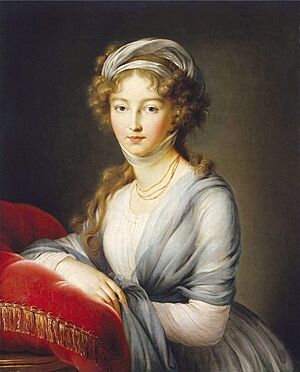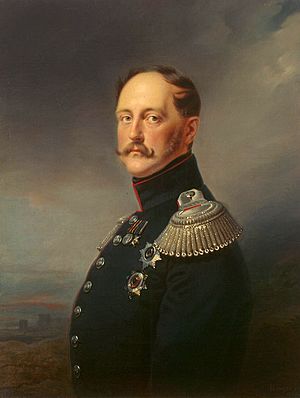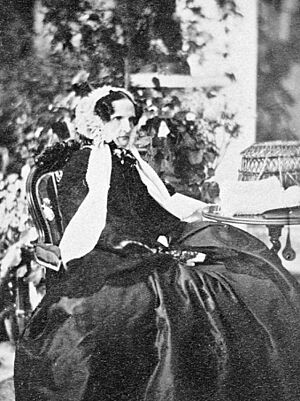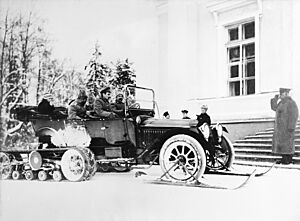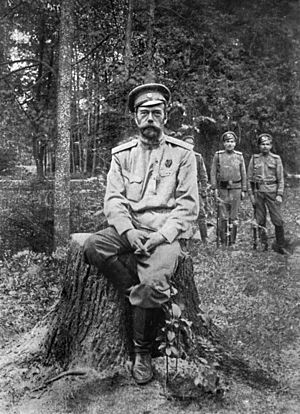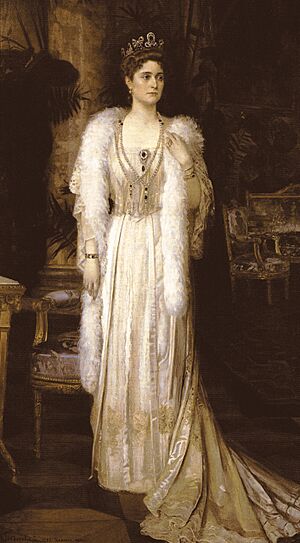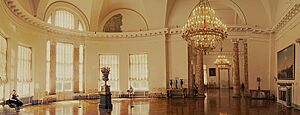Alexander Palace facts for kids
Quick facts for kids Alexander Palace |
|
|---|---|
|
Александровский дворец
|
|
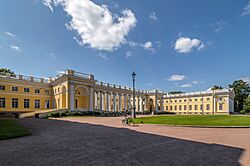
Alexander Palace in Tsarskoye Selo
|
|
| General information | |
| Type | Imperial residence |
| Country | Russia |
| Coordinates | 59°43′16″N 30°23′33″E / 59.721°N 30.3926°E |
| Construction started | 1792 |
| Design and construction | |
| Architect | Giacomo Quarenghi |
The Alexander Palace is a beautiful former home of the Russian emperors. It is located near the town of Tsarskoye Selo in Russia, about 30 miles (48 km) south of Saint Petersburg. This grand palace was ordered by Catherine the Great in 1792.
The Alexander Palace became the favorite home of the last Russian Emperor, Nicholas II, and his family. They liked its privacy and safety, especially compared to the Winter Palace in the city. Nicholas II's oldest child, Grand Duchess Olga Nikolaevna of Russia, was born here. In 1917, after the February Revolution during World War I, the palace became the family's first place of imprisonment. The Alexander Palace is in Alexander Park, close to the larger Catherine Palace. After many years of repairs, the Alexander Palace opened in the summer of 2021 as a museum. It now shows items from the old imperial family.
Contents
- Building the Palace for Catherine the Great
- Home for Grand Duke Alexander and Elizaveta
- Under Emperor Nicholas I
- Under Alexander III and Maria Feodorovna
- Under Nicholas II and Alexandra Feodorovna
- The Romanovs Under House Arrest
- After the Romanovs Left
- German Occupation During World War II
- After the War
- Recent History and Restoration
- See also
Building the Palace for Catherine the Great
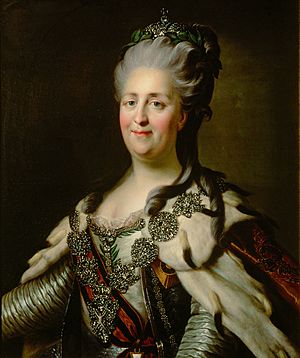
The Alexander Palace was built in the imperial countryside, near Tsarskoe Selo. Empress Catherine the Great (who ruled from 1762 to 1796) ordered its construction. She wanted it built for her favorite grandson, Grand Duke Alexander Pavlovich. He later became Emperor Alexander I of Russia. The palace was a gift for his wedding in 1793 to Grand Duchess Elizaveta Alexeievna.
The palace was designed in a Neoclassical style by Giacomo Quarenghi. It was built between 1792 and 1796. Many people thought the architect did an amazing job creating this beautiful building. An architect's son later wrote that the palace was elegant and simple. It combined usefulness with beauty. Its grand look and balanced design made it comfortable and stylish inside.
Home for Grand Duke Alexander and Elizaveta
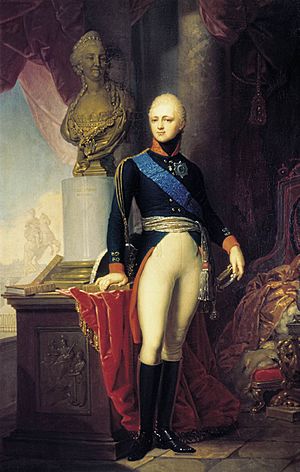
Grand Duke Alexander used the palace as a summer home. He lived there during the reigns of his grandmother, Catherine the Great, and his father, Emperor Paul. However, when Alexander became emperor, he chose to live in the much larger Catherine Palace nearby.
Under Emperor Nicholas I
Emperor Alexander I gave the palace to his brother, who would become Nicholas I. From then on, it was the summer home for the person next in line to the throne. Between 1830 and 1850, many rooms were redecorated. Artists like Eduard Hau and Luigi Premazzi painted beautiful watercolors of the palace's rooms during Nicholas's time.
A famous room built then was the Mountain Hall. It had a large slide for Nicholas I's children to play on. Nicholas I and his family lived in the palace from early spring until late autumn. In 1842, the imperial couple celebrated their 25th wedding anniversary with big parties. Two years later, Nicholas's daughter, Grand Duchess Alexandra, passed away at the palace. She was born there and spent her last months in the palace. On October 19, 1860, Empress Alexandra Feodorovna also passed away at the palace.
Under Alexander III and Maria Feodorovna
Emperor Alexander III and his wife, Maria Feodorovna, had their apartments in the western part of the palace. Before Alexander became emperor, Maria gave birth to their oldest child, the future Nicholas II, at Alexander Palace.
Alexander wrote in his diary about the birth of his first child. He described the joy and happiness when his son, Nicholas, was born. The whole imperial family was there for the birth. Maria wrote to her mother, Queen Louise, about how everyone helped her.
After Alexander III passed away, Maria Feodorovna would still visit the palace. She stayed in her old rooms when she visited her son, Tsar Nicholas II, and his wife, Alexandra Feodorovna. Over time, her visits became less frequent as she and Alexandra grew apart.
Under Nicholas II and Alexandra Feodorovna
The Alexander Palace is most famous for its role during the reign of the last tsar, Nicholas II. He and his wife, Alexandra Feodorovna, loved the palace very much. They decided to make it their main home after the events of Bloody Sunday in 1905. This event made the Winter Palace feel unsafe. They changed the old ballroom into new rooms, like the Maple Room and the New Study. They also added rooms for their children upstairs.
Alexandra and her architect chose a modern style called Art Nouveau for the decorations. This style was new and different for an imperial palace. One of the most famous rooms was Alexandra's Mauve Room, known for its purple color.
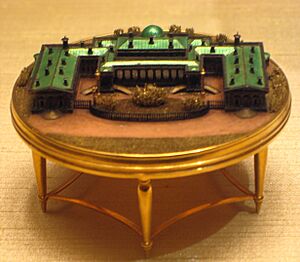
During Nicholas II's rule, the palace got electricity and a telephone system. In 1899, a special lift was put in to connect the Empress's rooms to the children's rooms on the second floor. They even had a movie screening room in the Semicircular Hall to watch films.
During the difficult years of war and revolution, the palace kept the Imperial Family safe from the outside world. Pierre Gilliard, who taught Nicholas II's son, said that family life at Tsarskoe Selo was less formal. The court usually did not live at the palace. The Imperial Family would eat meals together without many servants, unless relatives were visiting.
The Romanovs Under House Arrest
Nicholas II gave up his throne on March 2, 1917. Thirteen days later, he returned to Alexander Palace. He was no longer Emperor but was called Colonel Romanov. The Imperial Family was kept under house arrest. They were limited to a few rooms and watched by guards. They could not contact the outside world, except for approved letters.
Gilliard noted that the Empress and her daughters spent their free time sewing or weaving. They were always busy. During walks in the park, all family members, except the Empress, did physical work. They cleared snow, chopped ice, and cut dry branches for firewood. When the weather got warmer, the whole family worked in a large vegetable garden.
Because the situation in St. Petersburg was becoming dangerous, the government leader, Alexander Kerensky, decided to move the Romanov family. They were sent to Tobolsk in Siberia. Some people wanted them held in the Peter and Paul Fortress prison in St. Petersburg. To avoid this, on August 1, 1917, a train took the family away. They never returned to the Alexander Palace.
After the Romanovs Left
Soon after the Romanovs left for Siberia, the Alexander Palace became a museum. It stayed open until the start of World War II. When the war began, the most valuable items were moved to safer places inside the country. Other parts of the collection were hidden in the basement.
German Occupation During World War II
During the Nazi German occupation, the palace was used as a headquarters for the German military. The area in front of the palace became a cemetery for soldiers. Many unique art and historical collections were damaged or destroyed. As the German forces left the Soviet Union, they burned many imperial palaces. Luckily, the Alexander Palace was saved.
After the War
After the German forces were driven out, the palace was used to store artworks returning to the area. The nearby Catherine Palace had been looted and mostly destroyed. For a while, there were plans to restore the Alexander Palace's interiors. However, this decision was changed. Since the Soviet government did not encourage interest in Nicholas II and his family, they also did not focus on restoring their palace.
The new plan was to create a museum about the poet Pushkin. The private rooms of the imperial family were changed into plain exhibition halls. The museum plan was then put aside, and the palace was given to the Soviet Navy. Many of the palace's old collections still existed but were moved to other museums, like the Pavlovsk Palace. The Alexander Palace was seen mostly as just a part of the beautiful Alexander Park.
Recent History and Restoration
In 1996, the World Monuments Fund (WMF) listed the Alexander Palace as a site needing protection. With money from American Express, WMF helped fix the roof over Nicholas II's wing of the palace. This was about one-third of the building's roof.
In the summer of 1997, a permanent exhibit about the imperial family opened. Some parts of the Reception Room, Nicholas II's New Study, and Alexandra Feodorovna's Drawing Room were recreated. These rooms showed historical costumes, weapons, and art objects. A portrait of Alexandra Feodorovna was put back in its original spot. Clothes worn by the last imperial family and uniforms from Nicholas II's court were also displayed. Many of these clothes survived because they were used as packing material for more valuable items during World War II.
In 2010, the three largest public rooms in the middle part of the palace reopened after some restoration. These were the Semi-Circular Hall, the Portrait Hall, and the Marble Drawing Room. However, due to limited funds and scattered collections, the displays were somewhat simple.
In 2014, the Russian government finally gave a lot of money for a more complete restoration of the imperial family's living areas. This included Alexandra's Art Nouveau Maple Room and her famous Mauve Room. In September 2015, the palace closed to the public for this big, multi-year project.
In August 2021, the east wing of the palace reopened to visitors. The private apartments of Nicholas II and Alexandra Feodorovna were fully restored. These rooms include the New Study, the Moorish Bathroom, the Working Study, Nicholas' Reception Room, the Valet's Room, the Maple Drawing Room, the Pallisander Drawing Room, the Mauve Boudoir, Alexandra's Reception Room, the Imperial Bedroom, the Small and Large Libraries, and the Mountain Hall. The first floor of this wing, which used to have the rooms of Nicholas II's children, now has an exhibit of items belonging to the children of different emperors.
Plans are now being made to renovate the west wing. This part of the palace mostly held guest apartments during Nicholas II's time. These renovations are expected to be finished in the future.
See also
 In Spanish: Palacio de Alejandro para niños
In Spanish: Palacio de Alejandro para niños
- Chinese Village – a Chinese-style area in the Alexander Palace Park
- Catherine Palace – another palace in Tsarskoe Selo
- Gatchina Palace – summer home of Nicholas II's parents
- Pavlovsk – palace of Paul I and his wife Maria Feodorovna
- Peterhof – summer home of Nicholas II
- Emperor railway station in Pushkin town


